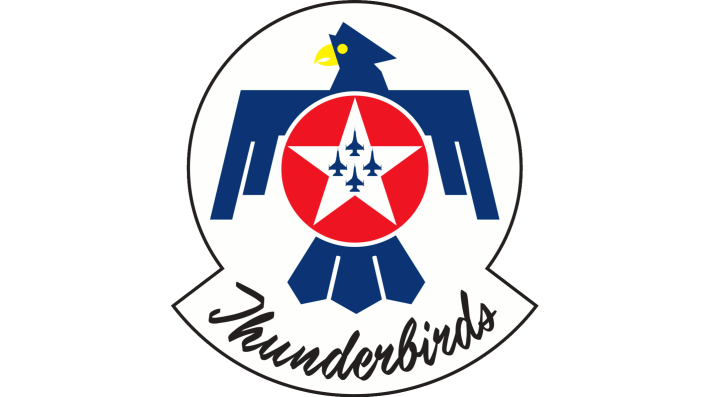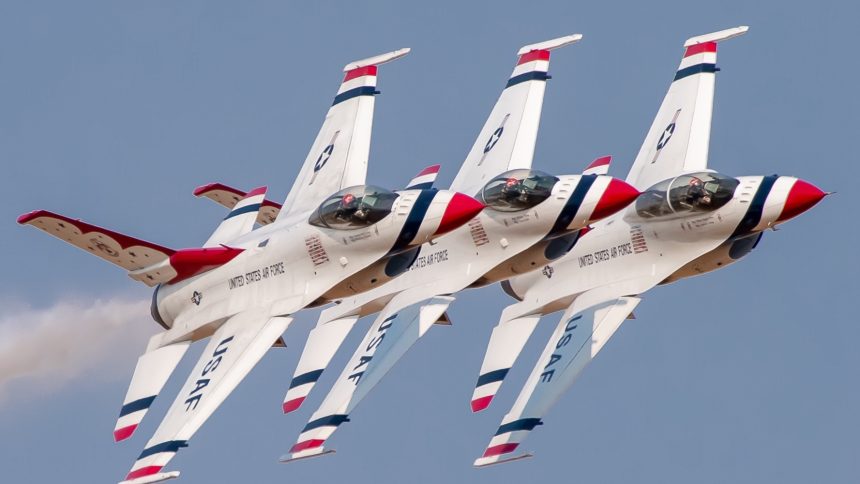Entertaining crowds since 1953, the United States Air Force Thunderbirds are one of the world’s best known aerial demonstrations teams, dazzling spectators in their familiar red, white, and blue aircraft.
Thunderbird Beginnings
Officially activated on Jun. 1, 1953 as the 3600th Air Demonstration Team, the United States Air Force (USAF) Thunderbirds are the third oldest air demonstration team in the world. First located at Luke Air Force Base (AFB) in Arizona, the team moved to its current home of Nellis AFB in Nevada in 1956. During the first six air shows, the team was known as the “Stardusters”, taking the name of “Thunderbirds” after influence a of Native American bird-like spirit creature resembling a hawk or eagle that could cast thunder from its wings and lightning from its eyes while ruling the skies. The first demonstration aircraft used by the team would be a straight-wing jet of which versions had seen action in the skies over Korea.
F-84G Thunderjet
The Republic F-85G was the first aircraft flown in a demonstration role by the USAF Thunderbirds. It made its first appearance on Jul. 1, 1953 at Nellis AFB in Nevada, with the first public appearance on Jul. 23.
Republic’s F-85G was a straight-wing single-seat jet powered fighter, entering service in 1951. Out of a total of 3,025 built, 789 went to the USAF, with the balance going to U.S. allies in order to quickly build up forces opposing Communism. The G model was nuclear capable, had aerial refueling capabilities, and was the final straight-wing variant of the F-84.
Powered by an Allison J35-A-29 turbojet, it could reach speeds of over 620 mph and had a service ceiling over 40,000 ft. The Thunderjet was 38 ft long with a wingspan of 36 ft 6 in, while the height was 12 ft 7 in. The F-84G served the Thunderbirds until the spring of 1955.
Since the F-84G was a single-seat aircraft, the Thunderbirds also operated a Lockheed T-33 Shooting Star two-seat trainer aircraft, used as for flights for VIPs as well as members of the press, and was flown by the team’s narrator. The T-33 served into the 1960’s in this role, painted in Thunderbird colors.
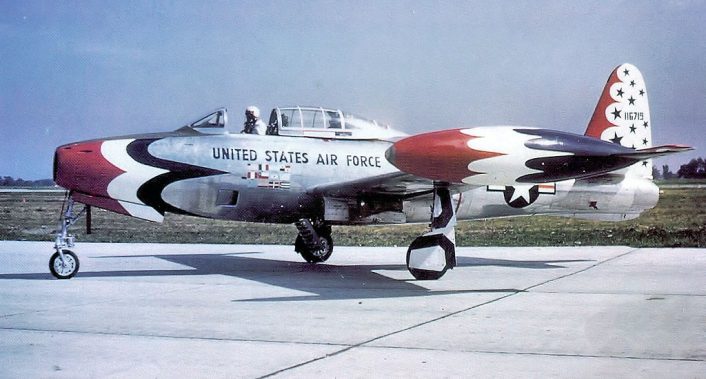
F-84F Thunderstreak
In the spring of 1955 the Thunderbirds transitioned to the F-84F Thunderstreak, a swept-wing and swept-tail version of the F-84G they had previously flown. The F-84F would serve the team until June 1956.
Republic had been working on a swept-wing version of the F-84 since 1949, however delays in production as well as continued runs of the straight-wing version G models as a stop-gap measure, prevented the F-84F from coming into production until November 1952, and not going operational until May 12, 1954. The swept-wing design, along with a new engine, the Wright J65-W1, did improve performance over the F-84G. Almost half of the production of 2,711 aircraft went to NATO (North Atlantic Treaty Organization) forces.
The fuselage of the F-84F was lengthened to over 43 ft to allow for the new engine, the wingspan was 33 ft 7.75 in and the height was 14 ft 4.75 in. The maximum speed increased to 695 mph, and the ceiling was 46,000 ft.
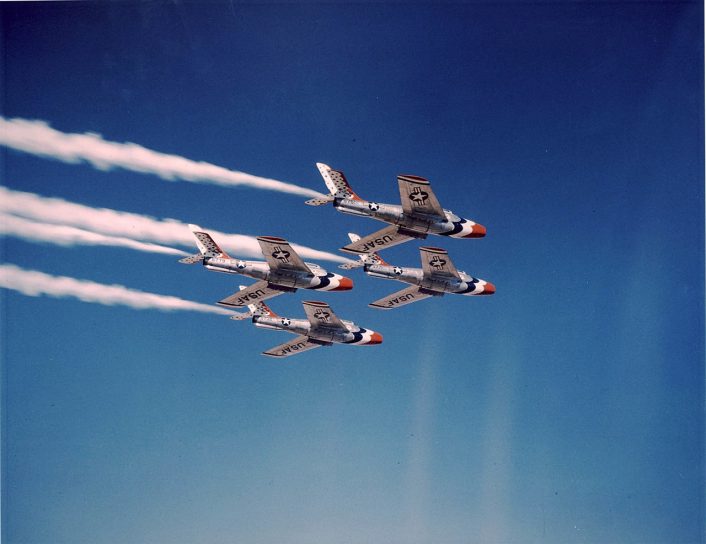
F-100C/D Super Sabre
In conjunction with the move to Nellis AFB, Nevada, the Thunderbirds also changed aircraft in 1956 to the North American F-100C Super Sabre. The F-100 was the first United States Air Force fighter to fly supersonic in level flight. The Thunderbirds were the first aerobatic team in the world to utilize a supersonic aircraft.
The debut of the F-100 was on Armed Forces Day at Nellis AFB on May 19, 1956. Supersonic low altitude passes were the highlight of demonstration, only to be banned by the Federal Aviation Administration (FAA) after a few shows. The F-100C would also be the first aircraft to be painted with the familiar Thunderbird silhouette on the underside of the aircraft body. F-100 would fly with the team for 13 years.
North American’s Super Sabre flew in Vietnam, used as a primary close air support missions. A total of 476 F-100C models were produced. The aircraft was 47 ft long with a 38 ft wingspan and height of 16 ft. Maximum speed was over 900 mph and the ceiling was 50,000 ft. Power was provided by a Pratt & Whitney J57-P-21 afterburning jet engine.
The F-100D differed from the F-100C with increased wing and tail surface areas, in-flight refueling capability, and improved avionics. The D model would fly with the Thunderbirds through the 1968 season. The F-100D was intended as a dedicated fighter-bomber.
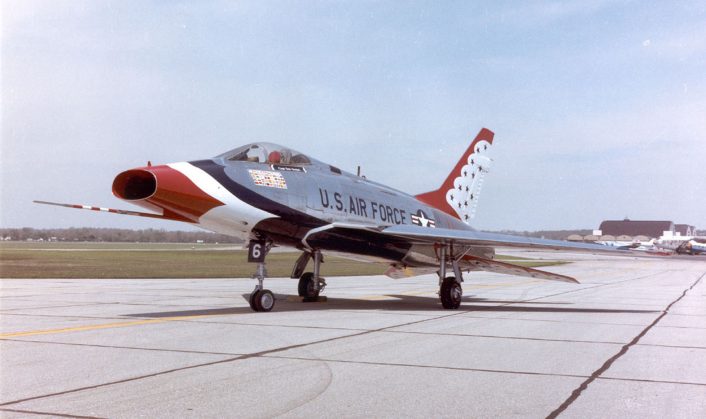
F-105B Thunderchief
For six shows in early 1964, the Thunderbirds flew the Republic F-105 Thunderchief. The Thunderchief was the first and only Thunderbird aircraft to dispense both red and blue smoke during demonstrations. The F-105B had a short-lived tour with team, after the fuselage of one of the aircraft broke in half on May 9, 1964 at Hamilton AFB, California. The aircraft exploded. The accident prompted the team to return to the F-100, this time the D model.
The F-105B was a large aircraft with a length of over 63 ft and a wingspan of 34 ft 11 in. Height was 18 ft 8 in and the aircraft could reach speeds of over Mach 2.
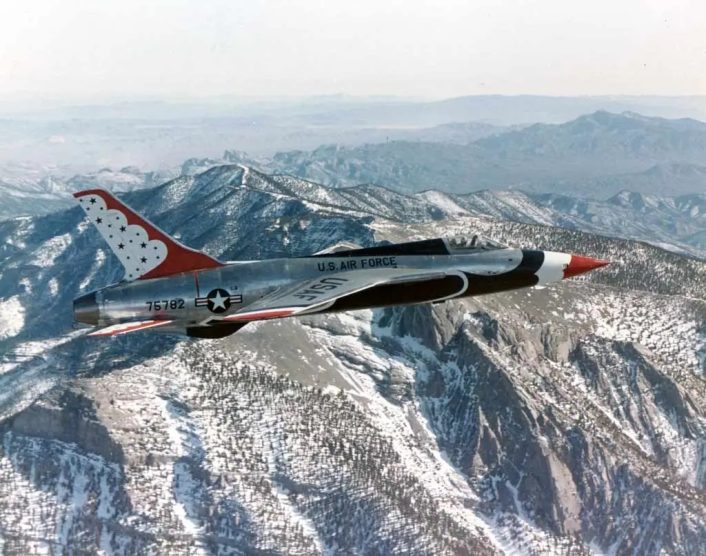
F-4E Phantom II
With President Richard Nixon on hand on Jun. 4, 1969, the Thunderbirds introduced their new demonstration aircraft in Colorado Springs, CO, the McDonnell Douglas F-4E Phantom II. For the first time the base color of the aircraft was now white instead of the previous bare metal/aluminum. The event was broadcast live as a means of raising the spirits of the American people, with the country involved in the Vietnam War.
The F-4 was a two-seat aircraft; the radio, navigation, and other equipment was removed from the rear seat and moved to the front. The Thunderbirds performed 518 demonstrations in the Phantom, including the smallest public crowd ever in Alaska of only 30 people.
The F-4 was also being flown by the U.S. Navy Blue Angels, and this would be the only time in history both teams operated the same aircraft at the same time. The F-4 flew with the Thunderbirds into 1973, when, like the Blue Angels, the oil crisis forced the team to look for a more economical aircraft. The F-4 last flew with the Thunderbirds in a show on Nov. 10, 1973.
McDonnell Douglas’ F-4E was a large and thirsty aircraft, having twin-engines, a length of 63 ft with a wingspan over 38 ft, and weighing in at over 61,700 lb fully loaded. Two General Electric J79-GE-17A afterburning turbojet engines insured the aircraft could reach Mach 2.27. The Phantom had a ceiling of 54,400 ft.
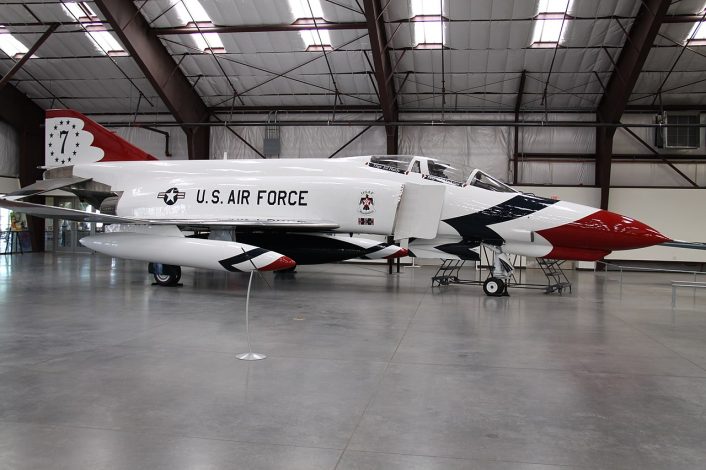
T-38 Talon
Northrup’s T-38 Talon two-seat trainer aircraft was chosen as the economical aircraft to replace the F-4 Phantom by the Thunderbirds in 1974. The T-38 was the first supersonic trainer in the world and five of them could operate using less fuel than one F-4. The T-38 flew only 35 shows in 1974. In 1976, the Bicentennial logo was applied to the tails of the T-38 in celebration of the 200th year of the American Revolution.
The T-38 was not a front-line fighter aircraft, and it had no aerial refueling capabilities, preventing overseas shows. It would be the T-38 the Thunderbirds were flying in 1982 when they suffered a training accident with four pilots being killed on Jan. 18. Demonstrations and operations are paused for 14 months following the accident and it would not be until April of 1983 the team would take to the skies again performing demonstrations.
The T-38 was only 46 ft 4.5 in in length, had a 25 ft 3 in wingspan with a height of 12 ft 10.5 in. Gross weight was 11,820 lb and it was powered by two General Electric J85-5A afterburning jet engines, giving it a maximum speed of Mach 1.3.
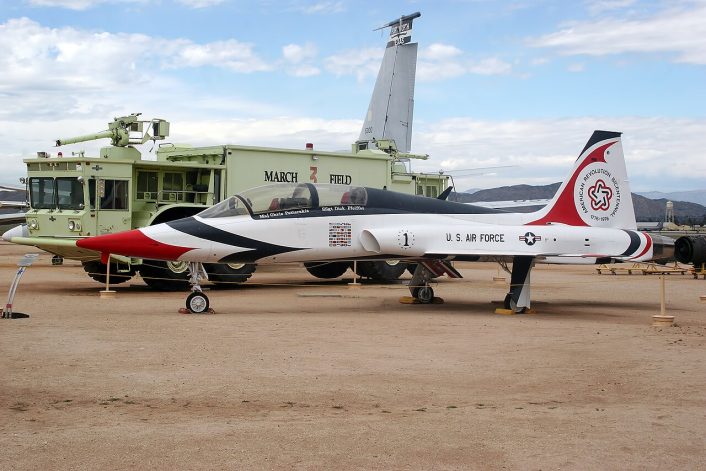
F-16A/C Fighting Falcon
Early in 1983, the Thunderbirds returned to flying front-line fighters during demonstrations, the General Dynamics F-16A Fighting Falcon. Flying the F-16, the Thunderbirds made the first American military flight demonstration in Beijing, China, in 1987. It was also the first such demonstration in a Communist country. The F-16A model was flown by the team until 1992, when they converted to F-16C models. In 1990 during the Gulf War, the team suspended demonstrations.
The F-16A is the single-seat variant, while the B model is the two-seat version. The F-16A has a maximum speed of over 1,300 mph, with a length of 49 ft 4 in and height of 16 ft 5 in. Wingspan is 32 ft 10 in. Widely exported and license-built throughout the world, the F-16 has been operational since January 1979.
The F-16C/D models entered production in 1984, began flying with the Thunderbirds in 1992, and they remain the team’s demonstration aircraft today. They feature upgrades in avionics, radar, and all-weather capabilities. During demonstrations the team operates six single-seat F-16C and two F-16D two-seat models, still based at Nellis AFB, Nevada.
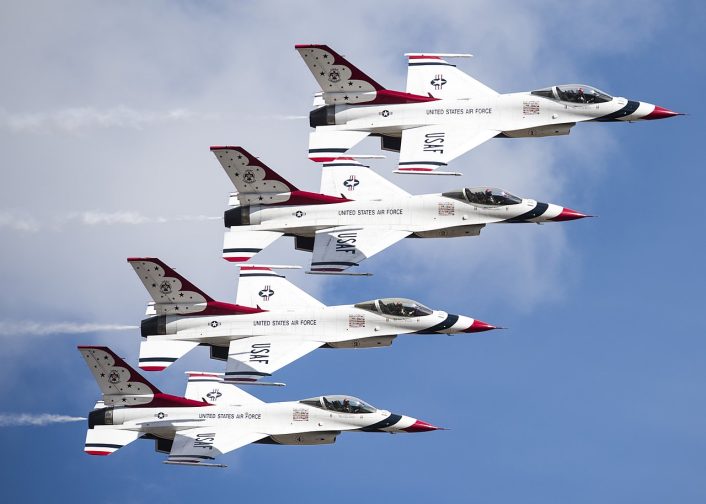
Support Aircraft
In 1955 the Thunderbirds received a C-119 Flying Boxcar painted in team colors as a support aircraft. The C-119 was a transport aircraft built by Fairchild powered by tow radial engines capable carrying 27,550 lb of cargo.
1956 brought the team a C-123D Provider transport plane for support, again painted in Thunderbird colors. The Provider was also manufactured by Fairchild and capable of transporting the team’s ground crews and equipment. The C-123D crashed on Oct. 9, 1958, killing 19 members of the support staff.
During the 1961 season, the Thunderbirds began operating a Douglas C-54D Skymaster as a support aircraft. The large four-engine aircraft was painted in Thunderbirds colors and named “The City of Las Vegas”. The C-54 is a military transport version of the DC-4 passenger aircraft, and it was used as part of the demonstration during air shows.
The Thunderbirds in more recent years and currently utilize contemporary transport aircraft such as the C-17, wearing conventional USAF colors and markings.
